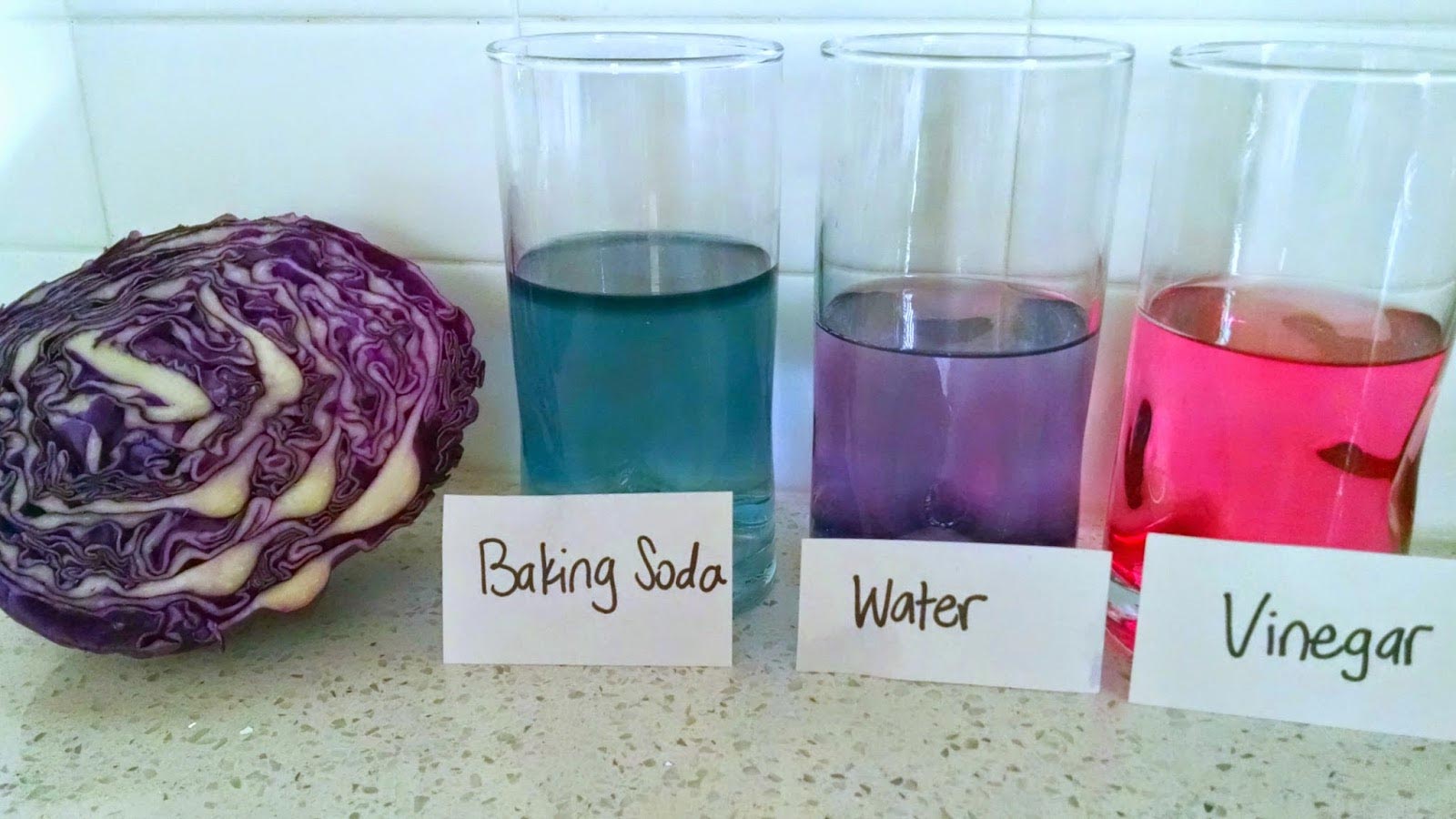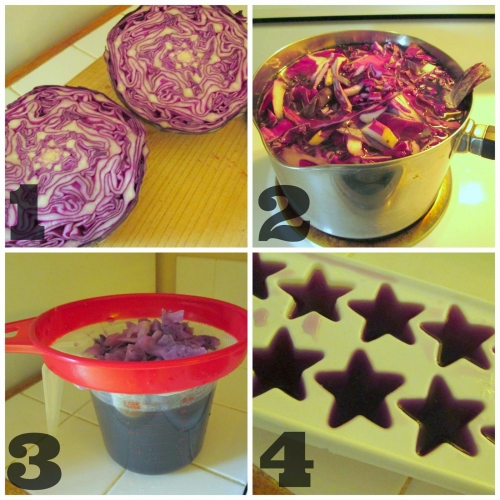Whether or not you like to eat red cabbage, you are going to love doing science with it by making your own red cabbage pH indicator. This is an amazing kitchen science experiment that turns solutions different colors as if by magic! Making a red cabbage indicator is a fantastic STEM activity to introduce children to acid/base chemistry.
Make a Red Cabbage pH Indicator
*This post contains affiliate links. Please see our disclosure policy.
Making a pH indicator from red cabbage is easier than might be expected. We headed to the kitchen to gather the following supplies:
- One half of a head of red cabbage
- Ice cube tray
- Tall clear cups
- Vinegar
- Baking Soda
- Water
- Optional: More acidic/basic household items such as lemon juice, washing soda, cream of tartar, or antacids

After gathering our supplies we followed these simple directions to make the red cabbage pH indicator solution:
- Chop up the red cabbage into small pieces. Place 2-3 cups in a saucepan and cover with water.
- Bring the solution to a boil and then turn off the heat. Let it sit for about 30 minutes to cool down.
- Pour the cabbage water through a strainer into a jar or large measuring cup. The dark purple liquid in the jar is the pH indicator liquid.
- Pour the red cabbage indicator liquid into the compartments of an ice cube tray. Freeze for a couple of hours to make ice cubes. (Save some of this out for the fantastic color changing chemical reaction. It will get the kids SO excited about learning science!)

Red Cabbage Experiment
Once our cabbage ice cubes were frozen solid we followed these instructions to perform the actual pH science experiment:
- Fill one cup with water (this is neutral, or the control), one with vinegar (this is acidic), and one with a teaspoon of baking soda mixed with water (this is basic).
- Drop a couple of indicator ice cubes into each cup. Notice how the colors change in each one.
- Repeat with other acidic or basic household items in other cups. Try to guess what color the solution will be before dropping an ice cube in!

I was shocked at how fast the colors of our cabbage indicator changed and how delightfully beautiful the colors were! My three-year-old daughter was excited because the solutions turned into her three favorite colors: pink, purple, and blue.
This cabbage juice indicator experiment can be found in 50 Science Things to Make & Do, along with several other hands-on and kid-friendly science activities.
Red Cabbage pH Indicator: How it Works
Scientists use the pH scale to describe the concentration of hydrogen protons in a solution. A pH of 7 means that the solution is neutral. It is neither basic or acidic. A pH less than 7 means the solution is acidic while a pH greater than 7 means the solution is basic. The lower the pH, the more acidic a solution is.

Red cabbage contains a chemical called anthocyanin that changes color depending on the acidity of its environment. In an acidic environment it is reddish-pink, in a neutral environment it is purple, and in a basic (or alkaline) environment it turns bluish-green and even yellow.
This is a great way to introduce the concept of acids and bases to a child since they can see the color change before their very eyes.
We used these same scientific principles to create an amazing fizzy color changing chemical reaction and to dye Easter eggs naturally, which were both so much fun. Who knows, maybe doing all this chemistry with red cabbage will inspire the kids to eat it one of these days 🙂

STEM With Real Eggs from Little Bins for Little Hands
Science Experiment Growing Crystal Rainbows from Frogs and Snails and Puppy Dog Tail







I love how you approached it. Very spectacular!
Wow! I cannot believe this is FURST I’ve seen your blog! It is SOO SUPER AMAZING!!! I cannot wait to start using these with my 5 year old! I needed something to get excited about besides Spring weather–Thank you SOO much for sharing all of these incredible ideas and linkys too 😀 !!! Your new subscriber 😉
So awesome! I’m going to have to try this. 🙂
Now I am interested in doing it ….thanks
I was trying this tonight, and my water turned dark blue(doesn’t appear purple at all). Should I do it again?
Hi Elizabeth, I would just use the dark blue cabbage water and see what happens when you drop into acidic or basic solutions. It could be very interesting!
There are a variety of reasons that your red cabbage water came out dark blue instead of purple. There may have been some kind of residue in your saucepan or there might be minerals in your water that make it slightly alkaline. The red cabbage you purchased may have been grown in more alkaline soil, too. Feel free to try it again with a different head of cabbage or using bottled water instead of tap water and see if it comes out purple. And let me know what you find out from your experimentation!
Do you recommend distilled water versus tap water to prevent mineral contamination?
It probably depends on what’s in your tap water! I have always used tap water, but I can certainly see the benefit of using distilled water to prevent contamination. I have had some readers write in to say that even the “neutral” tap water turned blue, so if that happens, I would give it another try with distilled water. Great question, thanks for asking.
it works better if the cabbage water is hot chemical reaction happen faster the more broken down ad hotter the compounds are take the class cup of baking soda and dont add water just really hot to boiling purple cabbage and the reaction will happen a lot quicker. also use a glass cooking pan to boil the water the metal can become ionized and try a controlled water boil with distilled water and cabbage and then tap to see if your results vary they should but bottled water from different companies can have different ph so watch out!
what if i use the liquid cabbage as an indicator instead of the icecubes??would that still work the same way?
Yes, that will work the same way!
Thanks for this! I have small classes so a little cabbage goes a LONG way. I was just wondering if it would be ok to freeze it, and I came across this post. This is great!
My daughter is doing this for her DI project
thats pretty cool. i dont have red cabbage at home though.
i need to do this for my chem project for school, and I don’t have red cabbage. What are the other alternatives I can use? Tq.
There aren’t really ready alternatives. Red cabbage is available at the grocery store though!
Wow this was amazing. Thank you so much.
Would it work if I use the red cabbage indicator as a liquid instead of freezing them, or is freezing mandatory
Don ‘t reply it worked
So cool! I’ve done this experiment for years using just jarred red cabbage juice. I’ve never actually made the juice, or used it as ice cubes. I’m excited to try it with the cabbage instead of from a prepared food. I’m especially glad I found this because we study pigments of the leaf in the fall and do a chromatography experiment – this is such a nice tie in with anthocyanin. What is the advantage of using ice cubes instead of the liquid? Thanks!
It’s just a little variation of the same old experiment. It keeps the kiddos interested to mix it up sometimes 🙂 And the color change happens more slowly as the ice cube melts, which is pretty cool.
by chance do you know how long this took to melt in the substances?
It’s basically instantaneous!